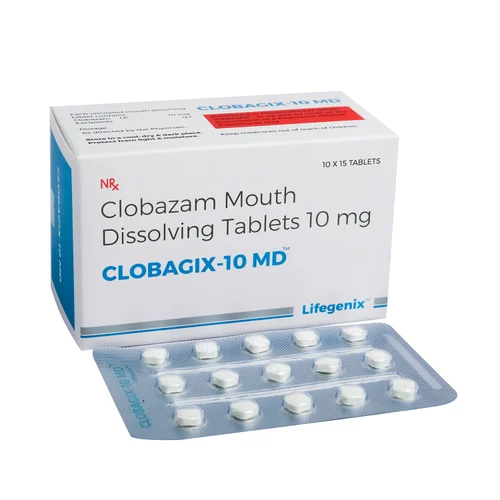💊 Clobazam Tablet 10 mg
📌 1. Prescription / Indication:
Clobazam 10 mg is primarily used in:
- Adjunct treatment of epilepsy, especially:
- Lennox-Gastaut syndrome
- Generalized and focal (partial) seizures
- Short-term management of severe anxiety (under strict medical supervision)
- Occasionally in acute agitation, spasticity, or muscle stiffness
📄 2. Description:
- Form: Oral tablet
- Strength: 10 mg Clobazam
- Appearance: Typically round, white or off-white tablets, often scored
- Administration: Oral use
- Prescription: Required (Schedule H / Schedule IV controlled drug in many countries)
🔬 3. Nature / Pharmacological Class:
- Drug class: Benzodiazepine derivative
- Type: Long-acting anxiolytic and anticonvulsant
- Mechanism: Enhances GABA-A receptor activity → increased neuronal inhibition (calming effect)
🌟 4. Advantages:
- Effective adjunct in refractory epilepsy (especially in children)
- Less sedating than other benzodiazepines (e.g., diazepam)
- Long half-life → once or twice daily dosing
- Also reduces anxiety associated with epilepsy
📦 5. Common Packaging:
| Packaging Form | Quantity |
|---|---|
| Blister strips | 10 or 15 tablets per strip |
| Bottles (less common) | 30 or 100 tablets |
🧊 6. Storage Guidelines:
- Store below 25°C
- Keep in a dry place, away from moisture
- Protect from direct sunlight
- Keep out of reach of children
👩⚕️ 7. Patient Advice:
- Take exactly as prescribed—do not adjust or stop abruptly
- Best taken with food to minimize gastrointestinal upset
- May cause:
- Drowsiness
- Dizziness
- Unsteadiness
- Behavioral changes (especially in children)
- Avoid alcohol, driving, or heavy machinery
- Do not stop suddenly—risk of withdrawal seizures
- Inform your doctor if:
- You are pregnant or planning pregnancy
- You experience mood changes, aggression, or suicidal thoughts
🎯 8. Purpose / Therapeutic Use:
- Seizure management (especially resistant or mixed seizures)
- As a supportive anticonvulsant with other AEDs
- Short-term use in anxiety, if other treatments fail
⚠️ 9. Warnings / Precautions:
- Not for long-term anxiety treatment
- Use caution in:
- Elderly patients (risk of falls, sedation)
- Patients with liver or kidney impairment
- Risk of:
- Drug dependence
- Tolerance
- Withdrawal symptoms
- Use with caution in respiratory depression, sleep apnea, or myasthenia gravis

